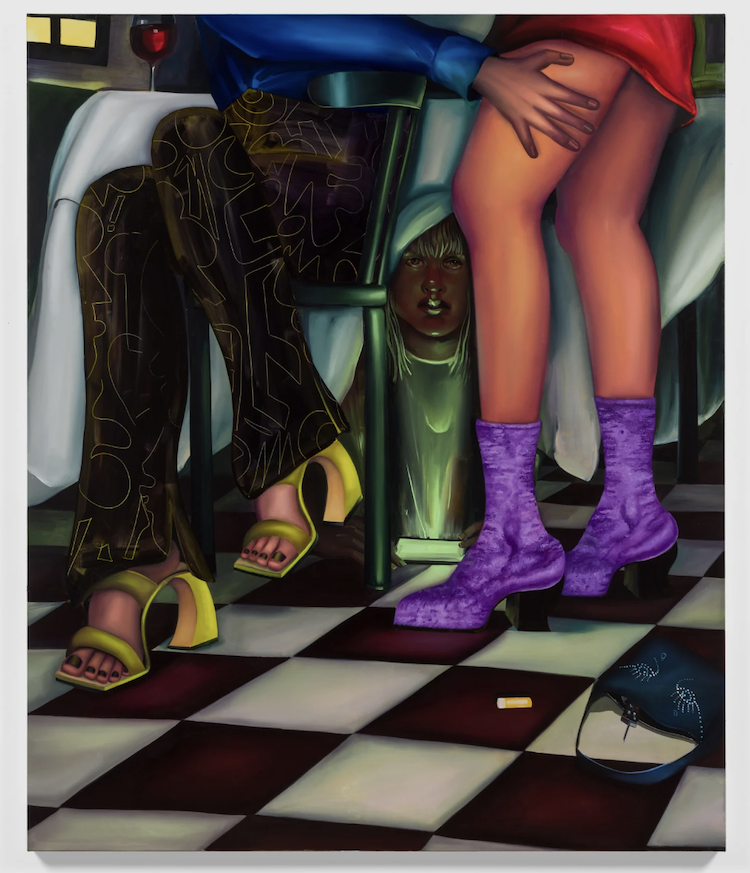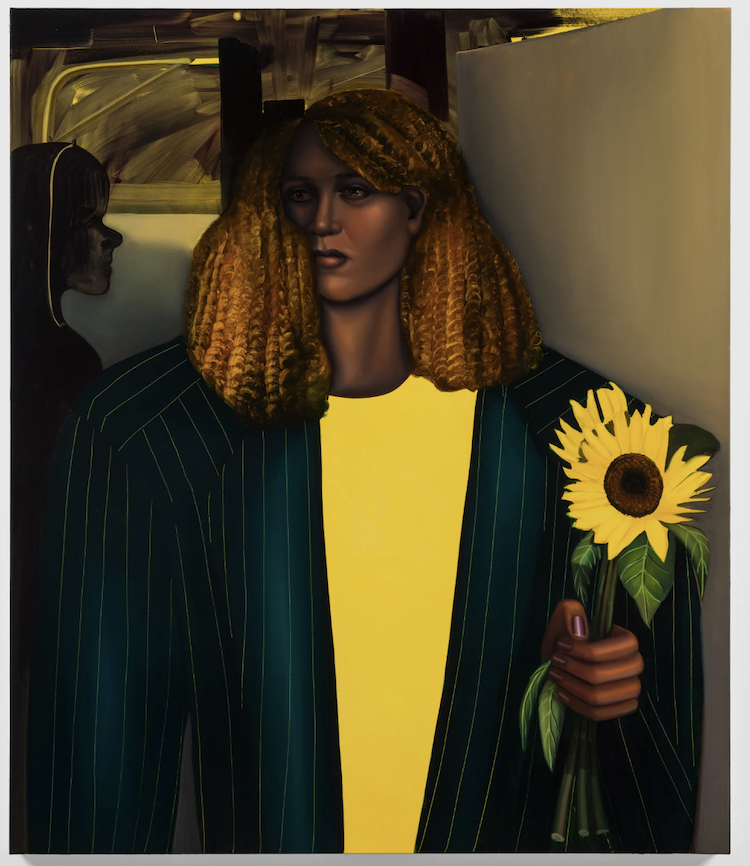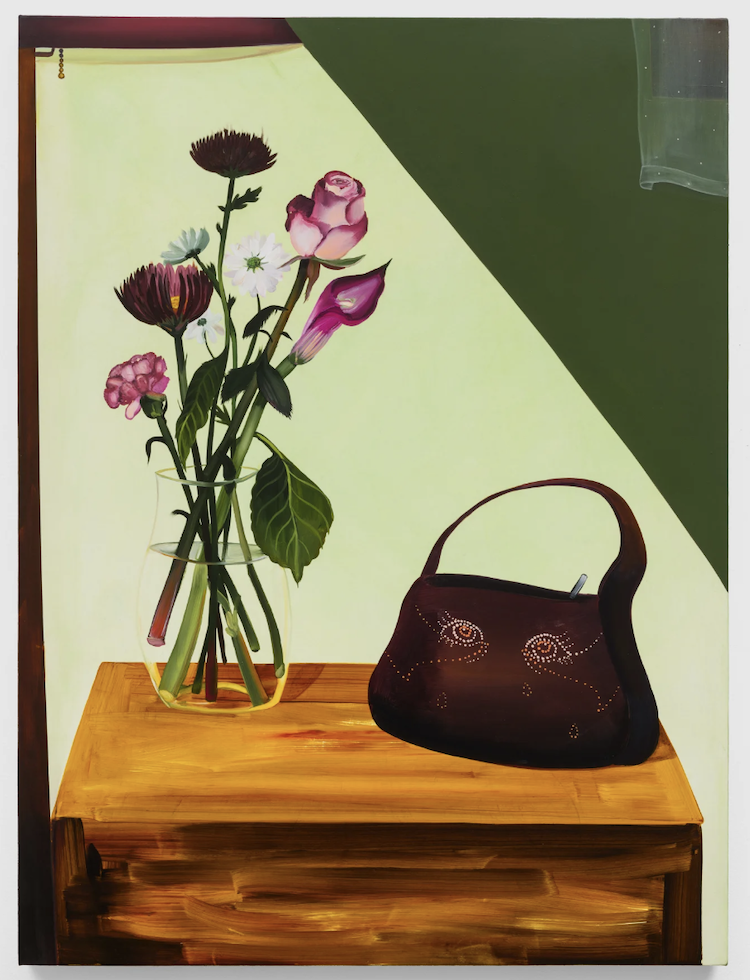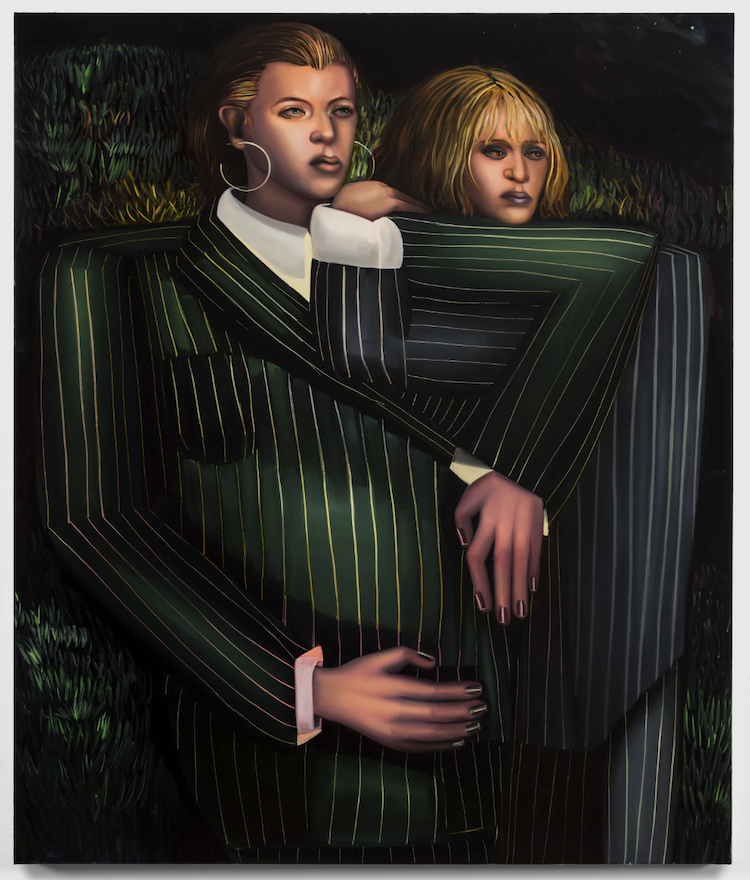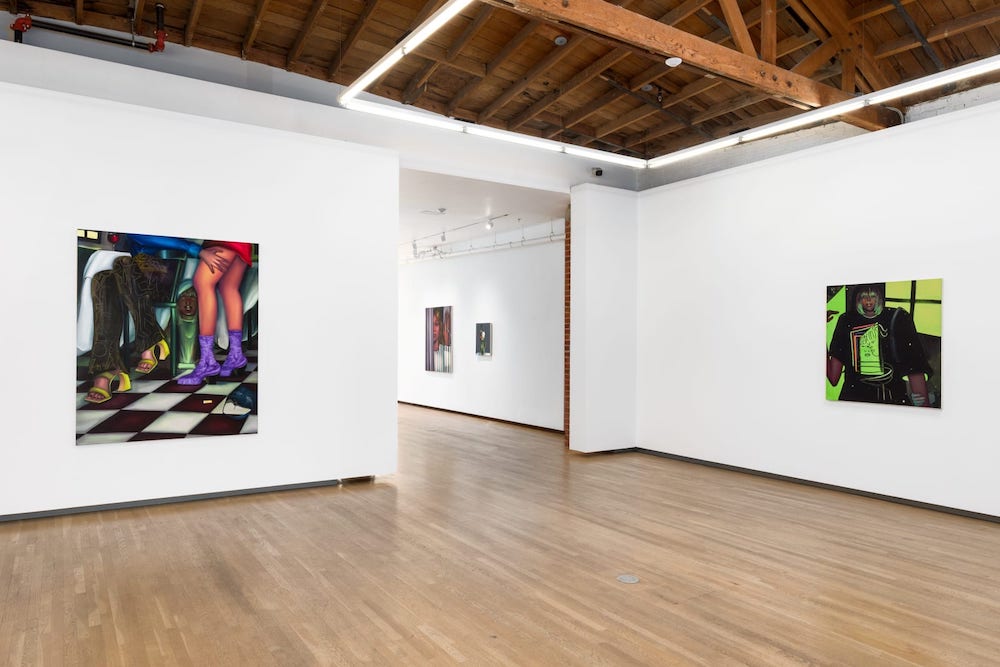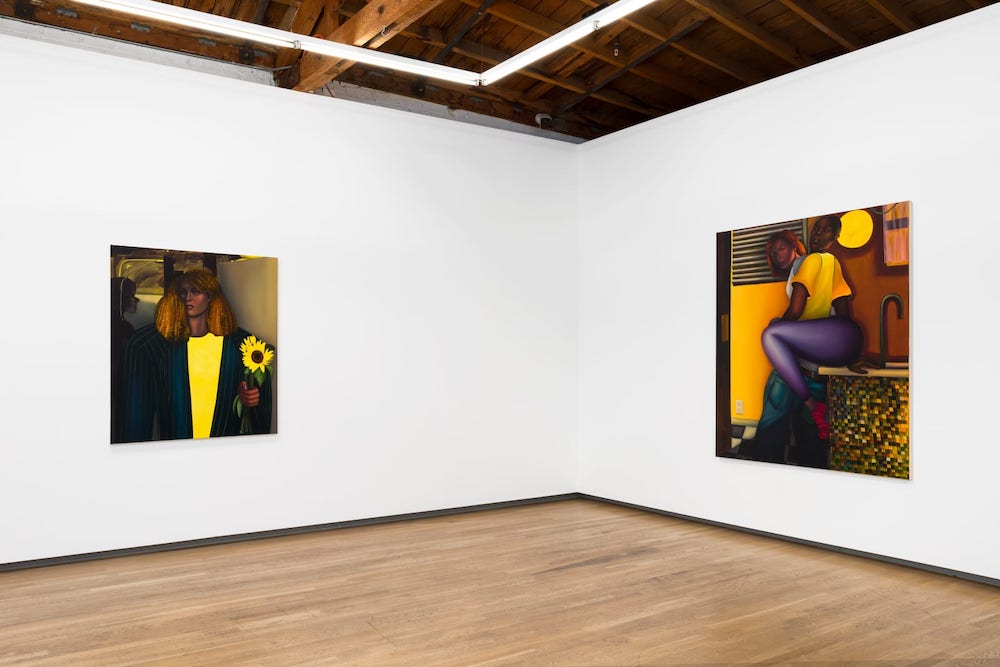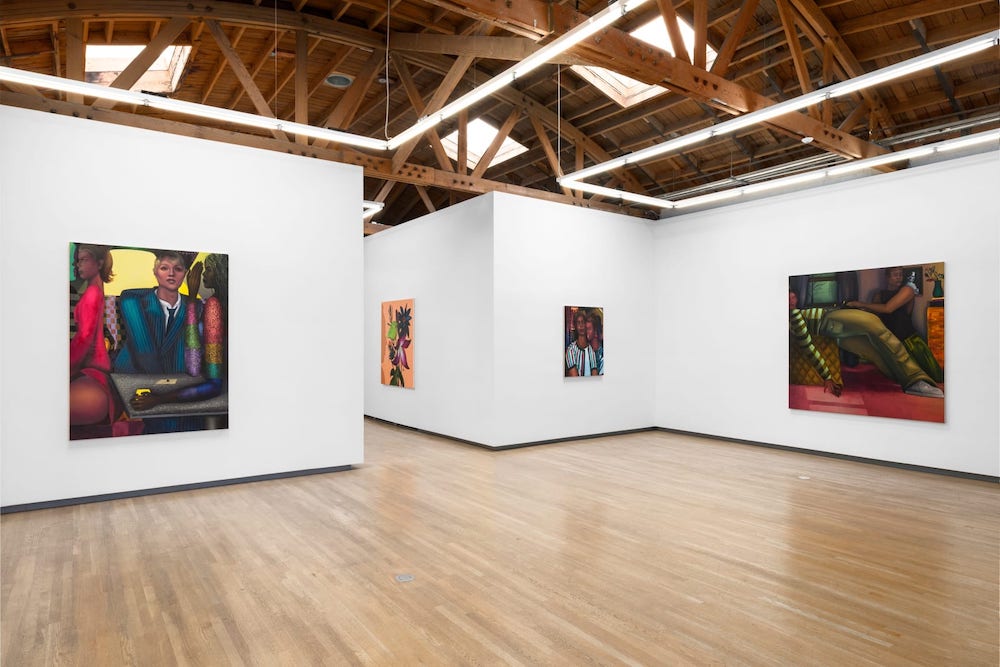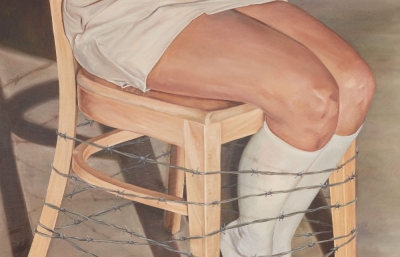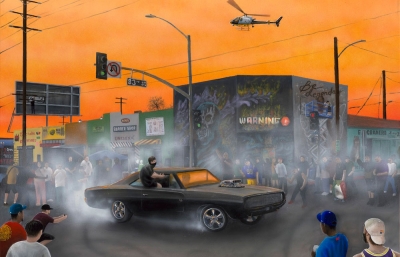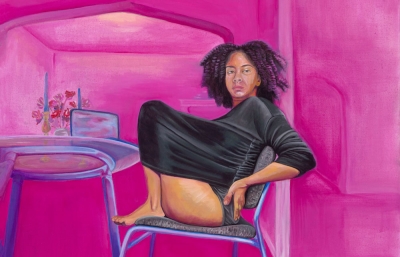Shulamit Nazarian is pleased to announce Rabid Heart, an exhibition by Philadelphia-based artist Coady Brown. This exhibition marks the artist’s second solo show with the gallery, on view through May 13, 2023.
Coady Brown’s paintings thoughtfully orchestrate psychologically charged environments that pulse with a sense of cinematic mystery and wonder. The figures that inhabit this world are rendered with a careful awareness of the politics inherent in depicting feminine and androgynous figures, illustrating a dedication to methods of representation that shield figures from the binds of voyeurism and over-determination. The paintings presented hone the artist’s long-standing commitment to depicting wholly autonomous figures, cultivating and preserving an interior psychology impermeable to the viewer and artist alike. Rabid Heart celebrates the uninhibited passion, verve, and power these figures retain, regardless of those watching.
Brown’s practice examines how groups, couples, and solitary figures navigate self-presentation in private and public life. Located across domestic interiors, nightclubs, and transitory public settings, figures are compressed into tightly framed, intimate spaces that expose the subtle complexities of interpersonal connections and relationships. Brown stages her scenes to pinpoint the ways expression is negotiated across different environments, lingering in moments when people are free to present themselves in their most natural states. In Dark Matter, one such scene located at the edge of a nightclub, a hand from the lowermost register grasps around the central figure’s arm. Illuminated by the club lighting, the composition brings a quiet embrace to our attention while the exchange remains under the private cover of darkness.
Rendered in reaction, though not exclusively in opposition, to traditional Western portraiture and its tendency toward reductive depictions of women, the figures themselves have no living referent beyond an amalgamation of individuals closest to the artist. Invested in capturing the nuances of her communities’ lives and experiences, her primary interest is the manner in which women’s stories are told and the different vehicles that carry out their narratives. She shares, “It’s not that I’m making some kind of ideal. I felt compelled to make things that are true to my experiences—of what it’s like to be a woman in the world, to be looked at, to be consumed, to have my own autonomy—how is that represented? It’s a lifelong continuation of this agenda to try to capture what it feels like to exist in the world, to try to make that an image.”
The artist’s sense of responsibility in depicting femininity looms over the works of Rabid Heart, as Brown foregrounds the correlation between vulnerability and femininity—or, more precisely, the disproportionate risk of harm in the absence of masculinity—throughout her painting process. Here, Brown’s compositional strategy to crop and conceal the individuals’ physical forms carries a dual signification. Borrowing techniques of geometric abstraction and op art, she shields figures by abstracting the shape of their bodies to rectilinear planes of color and pattern, deemphasizing contours of the body and allowing the figures’ chosen garments and accessories to communicate their selfhood. In connection with her figures, flower bouquets punctuate the exhibition and are symbolic of all sorts of deeply personal relationships: an expression of care, gratitude, love, grief.
Brown utilizes several of these strategies for self-presentation in the painting Out of Reach, a club scene that features three figures, each presenting their femininity in different ways. Composed below the sightline of a table, the staging omits the faces of two of the figures altogether. A seated figure pares an electric blue satin blouse with dynamically patterned slacks, their polished toes peeking out of yellow block-heeled sandals. They reach across to embrace the bare thigh of a standing figure who wears bright purple boots and a short red skirt. The face of the third figure peers out from underneath the tablecloth, staring directly at the viewer, illuminated only by the light of their phone screen. A dark blue handbag that appears across a number of the paintings in Rabid Heart lies on the floor. Embroidered with expressive lashed eyes, the purse looks out at the viewer, just as the figure does. Here, Brown methodically diverts the narrative of the scene away from the visible bodies. The viewers’ eyes are directed to their clothing and accessories—the ways they have chosen to present themselves. In this way, Brown’s use of heels, jewelry, nail polish, lipstick, purses, and other objects of femininity elevates them from their connotation as unserious quotidian accessories, instead positioning them as symbols of the figures’ agency in their self-presentation.
Throughout Rabid Heart, our perspective revolves around the figures’ choices and the intimacies among them, preserving the insularity of their world. Whatever powerful, sensual, or spiritual forces affecting the figures in the moments we observe are never overtly defined by the artist. The intensity of their shared experiences remains inaccessible to us, maintaining their privacy and positioning us as outsiders, but not as voyeurs. Brown shares, “These figures have their own emotional intelligence and they’re allowed to exist in total autonomy. They inhabit their own psychological spaces that we can observe, but don’t have access to. These aren’t portraits of people that exist, but I paint them until they feel real.”
Beyond daily life, self-styling, and histories of portraiture and abstraction, Rabid Heart gets at authorship and disclosure: how does an individual navigate self-presentation when their visibility reveals vulnerability outside of their control? We define ourselves with our actions, accessories, and communities, but our bodies remain subject to external projections. Brown addresses this by subverting the object of the viewers’ gaze. Through attention to lighting, vibrant clothing, and high-contrast colors, the figures’ inscrutable expressions hint at an unknowable and independent selfhood, conjuring a precise instant within a specific and stylized world.





